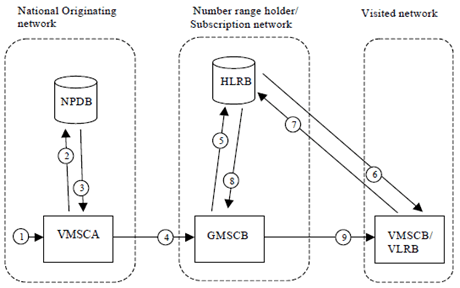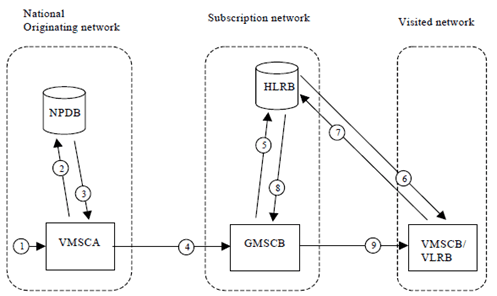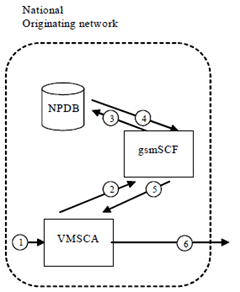Content for TS 23.066 Word version: 18.0.0
A.1.4 NP Query in Originating Network
A.1.4.1 OQoD - Number is not ported
A.1.4.2 OQoD - Number is ported
A.1.4.3 IN-Query for CAMEL pre-paid service
...
...
A.1.4 NP Query in Originating Network p. 23
A.1.4.1 OQoD - Number is not ported p. 23
Figure A.1.4.1 shows the architecture for a call where already the Originating network has the knowledge whether the MSISDN is ported or not and can route the call directly to the Subscription network that in this case is the same as the Number range holder network.

- A call is initiated by Mobile Subscriber A towards Mobile Subscriber B, using the MSISDN of the called subscriber.
- When VMSCA receives the call setup indication, it will send a database query to the NPDB as a result of analysis of the received MSISDN, including the MSISDN in the query.
- The NPDB detects that the MSISDN is not ported and responds back to the VMSCA to continue the normal call setup procedure for MO calls. Depending on database configuration option, the NPDB could either return a Routeing Number on not ported calls, as done for ported calls, or the call is further routed using the MSISDN number only towards the Number range holder network.
- The call is routed to the Number range holder/Subscription network based on the MSISDN or Routeing Number carried in ISUP IAM message.
- The GMSCB requests routeing information by submitting a MAP SRI to the HLRB, including the MSISDN in the request.
- The HLRB requests an MSRN from the MSC/VLRB where the mobile subscriber currently is registered.
- The MSC/VLRB returns an MSRN back to the HLRB.
- The HLRB responds to the GMSCB by sending an SRI ack with an MSRN.
- GMSCB uses the MSRN to route the call to VMSCB.
A.1.4.2 OQoD - Number is ported p. 24
Figure A.1.4.2 shows the architecture for a call where already the Originating network has the knowledge that the MSISDN is ported and can route the call directly to the Subscription network without involving the Number range holder network.

- A call is initiated by Mobile Subscriber A towards Mobile Subscriber B, using the MSISDN of the called subscriber.
- When VMSCA receives the call setup indication, it will send a database query to the NPDB as a result of analysis of the received MSISDN including the MSISDN in the query.
- The NPDB detects that the MSISDN is ported and responds back to the VMSCA with a Routeing Number pointing out the Subscription network.
- The call is routed to the Subscription network based on the Routeing Number carried in ISUP IAM message; also the MSISDN is included in IAM.
- The GMSCB requests routeing information by submitting a MAP SRI to the HLRB, including the MSISDN in the request. The capability to route messages to the correct HLR is required.
- The HLRB requests an MSRN from the MSC/VLRB where the mobile subscriber currently is registered.
- The MSC/VLRB returns an MSRN back to the HLRB.
- The HLRB responds to the GMSCB by sending an SRI ack with an MSRN.
- GMSCB uses the MSRN to route the call to VMSCB.
A.1.4.3 IN-Query for CAMEL pre-paid service p. 25
Figure A.1.4.3 shows the architecture for a call or MO-Short-Message originated by a CAMEL pre-paid subscriber while roaming in the Home PLMN where the gsmSCF needs to know whether or not calling and called subscriber subscribe to the same PLMN in order to apply the correct charging tariff.

- A call or short message is initiated by Mobile Subscriber A towards Mobile Subscriber B, using the MSISDN of the called subscriber.
- When VMSCA receives the call setup indication, it will send a CAP IDP message to the gsmSCF. The IDP contains the called party's MSISDN.
- If the calling subscriber roams in her Home PLMN and the called subscriber's MSISDN indicates that the called subscriber subscribes to a PLMN within the calling subscriber's Home Country, the gsmSCF queries the NPDB based on the called party's MSISDN. Otherwise the tariff to be applied does not depend on the called subscriber's porting status and enough information to apply the correct tariff is available; go to 5.
- The NPDB returns a routing number to the gsmSCF pointing out the called subscriber's subscription network. Based on this information the gsmSCF applies the appropriate tariff for pre-paid subscriber A.
- The gsmSCF returns CAP AC and CAP CUE messages to the VMSCA.
- The call or short message is set up.